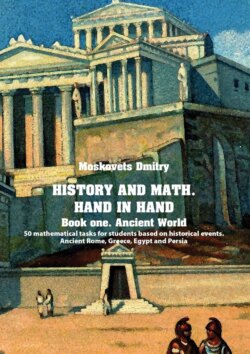Читать книгу History and math. Нand in hand. Book 1. Ancient World. 50 mathematical tasks for students based on historical events. Ancient Rome, Greece, Egypt and Persia - Dmitry Moskovets - Страница 4
Ancient Egypt
ОглавлениеAncient Egypt still beckons tourists with its amazing pyramids, mystical Sphinx, mysterious hieroglyphs…
E.1.Time scares everyone and fears pyramids
The largest pyramid in Egypt (probably, in the world) is the Great Pyramid of Giza (the tomb of Fourth Dynasty pharaoh Khufu1).
Scientists still have not reached a consensus and can only guess how and when it was erected. In Egypt, the official celebrated date of the start of the construction is August 26, 2540 BC. It is believed that the construction took 20 years. How many years has the pyramid been standing if the current date is 2017?
E.2. The first peace treaty
The first peace treaty was made before Christ by the great Pharaoh Ramesses II2 with the Hittite3 King. If Ramesses II had been born 9 years later, then by doubling the date of his birth, we would have gotten the date of the start of the construction of the pyramids (see the previous task). When did Ramesses II die, if, according to some sources, he lived for 66 years?
E.3. Gardens and cubits – what do they have in common?
After the war with the Nubian tribes, the Amenhotinox – one of the Egyptian military leaders, – gave his squire Hannumat with a small garden measuring 45 by 45 cubits4.
Can you count how many carrots he planted in the garden, if each cubit stood for 45 carrots? (Some may wonder why this problem is here, but it helps to practice mental counting. All actions can be done in mind using simple techniques)
E.4. What came first – Alexandria or Rome?
Certainly, Rome was founded earlier, the official date of its foundation is considered to be 753 BC. Alexandria was founded by Alexander the Great5 in Egypt nine years prior to his death. Both cities still exist. Determine which year Rome was twice as old as Alexandria.
E.5. Stadium and the Pyramids
Can pyramids be used for sports? The pharaohs hardly would have liked it.
Calculate how many laps one needs to make around the Great Pyramid of Giza to run a marathon distance of 42 km (see more about the marathon distance in task G. 10). The length of the pyramid’s side is 440 royal cubits6.
E.6. On a trip along the river Nile
At one time Thebes used to be the capital of Upper Egypt. The Pharaoh set in a boat downstream the Nile. Half the time servants rowed at 4 km/h, then a quarter of the time the passengers sailed at 6 km/h, the rest of the way the boat moved under sail and oars at 8km/h. Finally, the Pharaoh arrived to Memphis7, having travelled 726 km along the Nile. How many kilometers did the boat go under oars, if the daytime lasted for 12 hours?
1
Khufu was the second pharaoh of the Fourth Dynasty, in the Old Kingdom period. (2589—2566 BC or 2551—2528 BC)
2
Ramesses II was the third pharaoh of the Nineteenth Dynasty of Egypt that reigned around the 13 century BC.
3
The Hitties were an Anatolian people that lived in the Bronze Age.
4
A cubit is a unit of measurement that equals 45 cm.
5
Alexander III (Alexander the Great, 20/21 July 356 BC – 10 June 323 BC) of the Argead dynasty was a king and a military leader of the ancient Greek kingdom of Macedon, who created one of the largest empires in history that collapsed after his death. During his life, he came to be known as one of the greatest military leaders of all time.
6
A Royal cubit is a unit of measurement that equals 52.5 cm.
7
Memphis was an ancient Egyptian city. It existed from the early 3 century BC until the second half of the 1 century AD.
